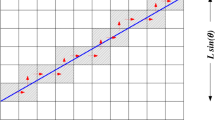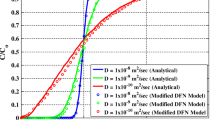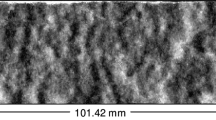Abstract
The discrete fracture network (DFN) model is a method to mimic discrete pathways for fluid flow through a fractured low-permeable rock mass, and may be combined with particle tracking simulations to address solute transport. However, experience has shown that it is challenging to obtain accurate transport results in three-dimensional DFNs because of the high computational burden and difficulty in constructing a high-quality unstructured computational mesh on simulated fractures. We present a new particle tracking capability, which is adapted to control volume (Voronoi polygons) flow solutions on unstructured grids (Delaunay triangulations) on three-dimensional DFNs. The locally mass-conserving finite-volume approach eliminates mass balance-related problems during particle tracking. The scalar fluxes calculated for each control volume face by the flow solver are used to reconstruct a Darcy velocity at each control volume centroid. The groundwater velocities can then be continuously interpolated to any point in the domain of interest. The control volumes at fracture intersections are split into four pieces, and the velocity is reconstructed independently on each piece, which results in multiple groundwater velocities at the intersection, one for each fracture on each side of the intersection line. This technique enables detailed particle transport representation through a complex DFN structure. Verified for small DFNs, the new simulation capability enables numerical experiments on advective transport in large DFNs to be performed. We demonstrate this particle transport approach on a DFN model using parameters similar to those of crystalline rock at a proposed geologic repository for spent nuclear fuel in Forsmark, Sweden.
Similar content being viewed by others
References
Adler, P.M., Thovert. J.-F., Mourzenko, V.V.: Fractured porous media. Oxford University Press (2012)
AMEC: ConnectFlow technical summary, release 10.4. AMEC report AMEC/ENV/CONNECTFLOW/15 (2012)
Ataie-Ashtiani, B., Lockington, D.A., Volker, R.E.: Numerical correction for finite-difference solution of the advection—dispersion equation with reaction. J. Contam. Hydrol. 23(1), 149–156 (1996)
Bear, J.: Dynamics of fluids in porous media, p 702. American Elsevier Publishing company Inc. (1972)
Berkowitz, B., Scher, H.: Anomalous transport in random fracture networks. Phys. Rev. Lett. 79(20), 4038 (1997)
Cacas, M.C., Ledoux, E, de Marsily, G., Tillie, B., Barbreau, A., Durand, E., Feuga, B., Peaudecerf, P.: Modeling fracture flow with a stochastic discrete fracture network: calibration and validation 1, The flow model. Water Resour. Res. 26(3), 479–489 (1990)
Coxeter, H.S.M.: Introduction to geometry. John Wiley and Sons, 216–221 (1969)
Cvetkovic, V., Frampton, A.: Solute transport and retention in three-dimensional fracture networks. Water Resour. Res. 48(2), W02509 (2012)
Cvetkovic, V., Painter, S.L., Outters, N., Selroos, J.-O.: Stochastic simulation of radionuclide migration in discretely fractured rock near the Äspö hard rock laboratory. Water Resour. Res. 40(2), W02404 (2004)
De Dreuzy, J.-R., Meheust, Y., Pichot, G.: Influence of fracture scale heterogeneity on the flow properties of three-dimensional discrete fracture networks (DFN). JGR 117, B1120 (2012)
Dershowitz, W.S., Lee, G., Geier, J., Foxford, T., LaPointe, P., Thomas, A.: FracMan Version 2.6. Interactive discrete feature data analysis, geometric modeling, and exploration simulation, user documentation. Report 923–1089, Golder Associates Inc. Seattle, Washington (1998)
Dershowitz, W.S., Fidelibus, C.: Derivation of equivalent pipe network analogues for three-dimensional discrete fracture networks by the boundary element method. Water Resour. Res. 35(9), 2685–2691 (1999)
Eikimo, B., Lie, K.-A., Eigestad, G.T., Dahle, H.K.: Discontinuous Galerkin methods for advective transport in single-continuum models of fractured media. Adv. Water Resour. 32(4), 493–506 (2009)
Elsworth, D.: A hybrid boundary element-finite element analysis procedure for fluid flow simulation in fractured rock masses. Int. J. Numer. Anal. Method Geomech. 10, 569–584 (1986)
Erhel, J, de Dreuzy, J.-R., Poirriez, B.: Flow simulation in three-dimensional discrete fracture networks. SIAM J. Sci. Comp. 31(4), 2688–2705 (2009)
FracMan and Mafic software: http://www.fracturedreservoirs.com/SolutionsMM.asp
Frampton, A., Cvetkovic, V.: Numerical and analytical modeling of advective travel times in realistic three-dimensional fracture networks. Water Resour. Res. 47(2), W02506 (2011)
Geier, J.: Investigation of discrete-fracture network conceptual model uncertainty at Forsmark. Swedish Radiation Safety Authority, Stockholm (2011)
Hartley, L., Cox, I., Holton, D., Hunter, F., Joyce, S., Gylling, B., Lindgren, M.: Groundwater flow and radionuclide transport modeling using connectflow in support of the SR Can assessment. Swedish Nuclear Fuel and Waste Management Co., Stockholm (2004)
Hartley, L., Joyce, S.: Approaches and algorithms for groundwater flow modeling in support of site investigations and safety assessment of the Forsmark site, Sweden. J. Hydrol. 500, 200–216 (2013)
Hogg, R.V., Craig, A.T.: Introduction to mathematical statistics. Macmillan, New York (1978)
Hyman, J.D., Gable, C.W., Painter, S.L., Makedonska, N.: Conforming Delaunay triangulation of stochastically generated three dimensional discrete fracture networks : a feature rejection algorithm for meshing strategy. SIAM Sci. Comp. 36(4), A1871–A1894 (2014)
Karra, S., Makedonska, N., Viswanathan, H.S., Painter, S.L., Hyman, J.D.: Effect of advective flow in fractures and matrix diffusion on natural gas production.Water Resour. Res., under review (2015)
Lichtner, P.C., Hammond, G.E., Lu, C., Karra, S., Bisht, G., Mills, R.T., Kumar, J., Andre, B.: PFLOTRAN: a massively parallel flow and reactive transport model for surface and subsurface processes, Los Alamos National Laboratory Technical Report No: LA-UR-15-20403, Los Alamos National Laboratory, Los Alamos, NM (2015)
Long, J.C.S., Remer, J.S., Wilson, C.R., Witherspoon, P.A.: Porous media equivalents for networks of discontinuous fractures. Water Resour. Res. 18(3), 645–658 (1982)
Martinez, M.J.: Comparison of Galerkin and control volume finite element for advection–diffusion problems. Int. J. Numer. Methods Fluids 50(3), 347–376 (2006)
Maryska, J., Severyn, O., Vohralik, M.: Numerical simulation of fracture flow with a mixed-hybrid FEM stochastic discrete fracture network model. Comput. Geosci. 8, 217–234 (2004)
Murphy, M., Gable, C.W.: Strategies for nonobtuse boundary Delaunay triangulations 7th International Meshing Roundtable Proceedings, pp 309–320. Sandia National Laboratory, Albuquerque (1998)
Neuman, S.P.: Trends, prospects and challenges in quantifying flow and transport through fractured rocks. Hydrogeol. J. 13, 124–147 (2005)
Nick, H.M., Matthäi, S.K.: Comparison of three FE-FV numerical schemes for single-and two-phase flow simulation of fractured porous media. Transp. Porous Med. 90(2), 421–444 (2011)
Outters, N., Shuttle, D.: Sensitivity analysis of discrete fracture network model for performance assessment of Aberg. R 00-48. Swedish Nuclear Fuel and Waste Management Co., Stockholm (2000)
Painter, S.L., Cvetkovic, V., Selroos, J.-O.: Transport and retention in fractured rock: consequences of a power-law distribution for fracture length. Phys. Rev. E 57(6), 6917 (1998)
Painter, S.L., Cvetkovic, V., Selroos, J.-O.: Power-law velocity distributions in fracture networks: numerical evidence and implications for tracer transport. Geophys. Res. Lett. 29, 1676 (2002)
Painter, S.L., Cvetkovic, V., Mancillas, J., Pensado, O.: Time domain particle tracking methods for simulating transport with retention and first-order transformation. Water Resour. Res. 44(1), W01406 (2008)
Painter, S.L.: User’s Manual for Walkabout Version 1.0. Los Alamos National Laboratory Technical Report No: LA-UR-11-01952, Los Alamos National Laboratory, Los Alamos, NM (2011)
Painter, S.L., Gable, C.W., Kelkar, S.: Pathline tracing on fully unstructured control-volume grids. Comput. Geosci. 16(4), 1125–1134 (2012)
Poteri, A.: Retention properties of flow paths in fractured rock. Hydrogeol. J. 15, 1081–1092 (2009)
Poteri, A., Nordman, H., Pulkkanen, V.-E., Smith, P.: Radionuclide transport in the repository near-field and far-field. Posiva Report 2014-02, Posiva Oy, Helsinki, Finland (2014)
Robinson, P.C.: Connectivity, flow and transport in network of fractured media. D.Phil Thesis. Oxford University (1984)
Selroos, J., Walker, D., Storm, A., Gylling, B., Follin, S.: Comparison of alternative modeling approaches for groundwater flow in fractured rock. J. Hydrol. 257, 174–188 (2002)
Selroos, J.O., Painter, S.L.: Effect of transport-pathway simplifications on projected releases of radionuclides from a nuclear waste repository (Sweden). Hydrogeol. J. 20(8), 1467–1481 (2012)
Selroos, J.O., Follin, S.: Overview of hydrogeological site-descriptive modeling conducted for the proposed high-level nuclear waste repository site at Forsmark, Sweden. Hydrogeol. J. 22(2), 295–298 (2014)
SKB: Radionuclide transport report for the safety assessment SR-Site. SKB TR-10-50, volumes I–III. Swedish Nuclear Fuel and Waste Management Co., Stockholm (2010)
SKB: Long-term safety for the final repository for spent nuclear fuel at Forsmark, SKB TR-11-01. Swedish Nuclear Fuel and Waste Management Co., Stockholm (2011)
Van Genuchten, M.T.H., Gray, W.G.: Analysis of some dispersion corrected numerical schemes for solution of the transport equation. Int. J. Numer. Methods Eng. 12(3), 387–404 (1978)
Versteeg, H.K., Malalasekera, W.: An introduction to computational fluid dynamics: the finite volume method. Pearson Education (2007)
Wahlgren, C.H., Curtis, P., Hermanson, J., Forssberg, O., Oehman, J., Fox, A., Juhlin, C.: Geology laxemar. Site descriptive modeling SDM-Site Laxemar. Swedish Nuclear Fuel and Waste Management Co., Stockholm (2008)
Zidane, A., Firoozabadi, A.: An efficient numerical model for multicomponent compressible flow in fractured porous media. Adv. Water Resour. 74, 127–147 (2014)
Zyvoloski, G.A.: FEHM: A control volume finite element code for simulating subsurface multi-phase multi-fluid heat and mass transfer. Los Alamos National Laboratory Technical Report No: LA-UR-07-3359, Los Alamos National Laboratory, Los Alamos, NM (2007)
Author information
Authors and Affiliations
Corresponding author
Rights and permissions
About this article
Cite this article
Makedonska, N., Painter, S.L., Bui, Q.M. et al. Particle tracking approach for transport in three-dimensional discrete fracture networks. Comput Geosci 19, 1123–1137 (2015). https://doi.org/10.1007/s10596-015-9525-4
Received:
Accepted:
Published:
Issue Date:
DOI: https://doi.org/10.1007/s10596-015-9525-4




